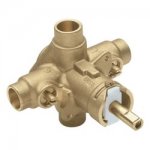In over twenty plus years in several jurisdictions not one inspector has ever taken the stand that the bond needs to be within 5' of where the water line enters the building. I don't see potable water in a house as two systems either.
You can attach one end of the bonding jumper to any place on the metallic water piping but the other end has to attach to one of the options in 250.104(A).
And one of the favorite sayings I hear is: "I've been doing it this way for thirty years and I've never heard that!" :happyyes:
Pete


